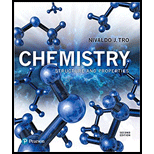
Concept explainers
To determine: Define oxidation and reduction and the basic procedure for
Answer to Problem 1E
Solution:
Oxidation is the loss of electrons. Reduction is the gain of electrons.
Explanation of Solution
When an atom loses electrons, it undergoes oxidation and has an increase in its oxidation state, which is an increase in the charge. The reverse is true for a reduction, where reduction is when an atom gains electrons and has a decrease in oxidation state which decreases the charge on the atom. To properly balance a
First you can assign oxidation states to each atom to find which atoms are being oxidized and reduced. We can see that Al goes from a charge of 0 to 3+, therefore, it is being oxidized. The Cu goes from 2+ to 0, which is a reduction. So, now we separate the two processes into two half reactions:
Oxidation:
Reduction:
Now, we need to balance the atoms of each half reaction, but in this case they are already balanced. The next step is to balance the reaction regarding charges, so to counter the positive charge on either side of the reaction; we add electrons to make the charge equal on both sides:
Now, we make the electrons in both half reactions equal, so we can multiply the top reaction by 2, and the bottom reaction by 3 resulting in 6 electrons total in each reaction:
Now, we can combine the two half reactions and cancelling any similar terms on both sides:
Oxidation is the loss of electrons and reduction is the gain of electrons. To properly balance the reactions, we use half reactions which separate the oxidation and reduction. Then we ultimately balance the atoms and charges, multiply each reaction so the electrons are the same in each reaction, and then combine the reactions to obtain the overall balanced reaction equation.
Want to see more full solutions like this?
Chapter 19 Solutions
Chemistry: Structure and Properties (2nd Edition)
- Two cations that exchange an electron in an interface, the exchange density is worth 1.39 mA/cm2 and the current density is worth 15 mA/cm2 at 25°C. If the overvoltage is 0.14 V, calculate the reaction rate and symmetry factor. Data: R = 8,314 J mol-1 k-1: F = 96500 Carrow_forwardWith the help of the Tafel line, it is estimated that the interchange density of the VO2+/VO2+ system on the carbon paper has a value of 3 mA cm-2. Calculate a) the current density if the voltage has a value of 1.6 mV and the temperature is 25°C. b) the beta value of the anódico process if the Tafel pendulum is 0.6 V at 25°C. Data: R = 8.314 JK-1mol-1, y F = 96485 C mol-1.arrow_forwardApply the NANSTE law to the MnO4- + 8H+ + 5e- ⇄ Mn2+ + 4H2Oarrow_forward
- An electrode process takes place at a metal-solution interface. Indicate the current condition that must be met for Faradaic rectification to occur.arrow_forwardAt a metal-solution interface, an electron is exchanged, and the symmetry factor beta < 0.5 is found in the Butler-Volmer equation. What does this indicate?arrow_forwardTopic: Photochemistry and Photophysics of Supramoleculesarrow_forward
 ChemistryChemistryISBN:9781305957404Author:Steven S. Zumdahl, Susan A. Zumdahl, Donald J. DeCostePublisher:Cengage Learning
ChemistryChemistryISBN:9781305957404Author:Steven S. Zumdahl, Susan A. Zumdahl, Donald J. DeCostePublisher:Cengage Learning ChemistryChemistryISBN:9781259911156Author:Raymond Chang Dr., Jason Overby ProfessorPublisher:McGraw-Hill Education
ChemistryChemistryISBN:9781259911156Author:Raymond Chang Dr., Jason Overby ProfessorPublisher:McGraw-Hill Education Principles of Instrumental AnalysisChemistryISBN:9781305577213Author:Douglas A. Skoog, F. James Holler, Stanley R. CrouchPublisher:Cengage Learning
Principles of Instrumental AnalysisChemistryISBN:9781305577213Author:Douglas A. Skoog, F. James Holler, Stanley R. CrouchPublisher:Cengage Learning Organic ChemistryChemistryISBN:9780078021558Author:Janice Gorzynski Smith Dr.Publisher:McGraw-Hill Education
Organic ChemistryChemistryISBN:9780078021558Author:Janice Gorzynski Smith Dr.Publisher:McGraw-Hill Education Chemistry: Principles and ReactionsChemistryISBN:9781305079373Author:William L. Masterton, Cecile N. HurleyPublisher:Cengage Learning
Chemistry: Principles and ReactionsChemistryISBN:9781305079373Author:William L. Masterton, Cecile N. HurleyPublisher:Cengage Learning Elementary Principles of Chemical Processes, Bind...ChemistryISBN:9781118431221Author:Richard M. Felder, Ronald W. Rousseau, Lisa G. BullardPublisher:WILEY
Elementary Principles of Chemical Processes, Bind...ChemistryISBN:9781118431221Author:Richard M. Felder, Ronald W. Rousseau, Lisa G. BullardPublisher:WILEY





